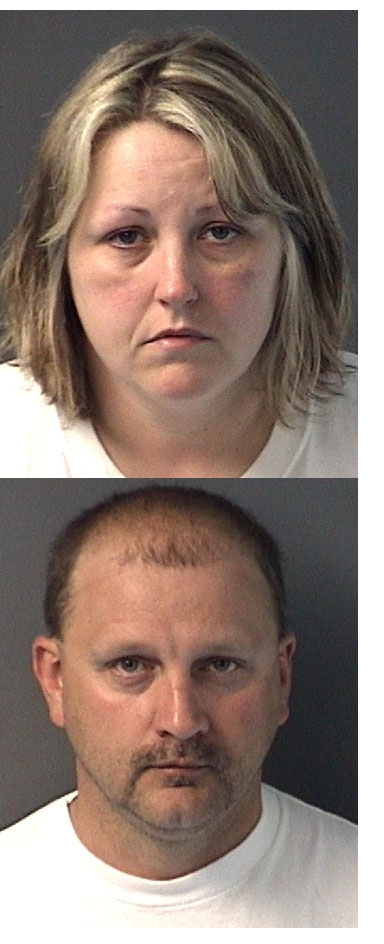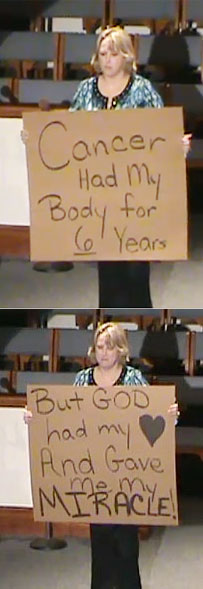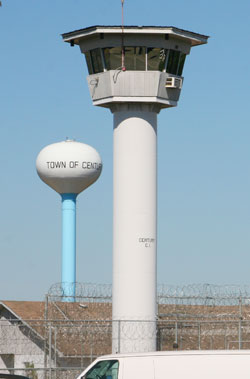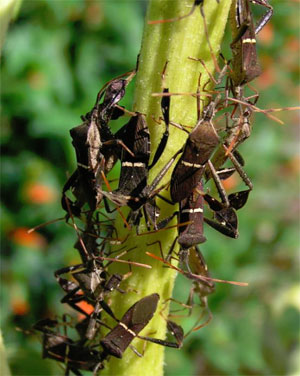Majority Of Florida Voters Disapprove Of Obama’s Performance
April 9, 2011
 Slightly more than half of Florida voters said they disapprove of the job President Barack Obama is doing, according to a poll released Friday.
Slightly more than half of Florida voters said they disapprove of the job President Barack Obama is doing, according to a poll released Friday.
The phone survey of voters taken in Florida March 29 to April 4 by Quinnipiac University found 52 percent of voters disapprove of Obama’s job performance while 44 percent approve.
About 4 in 10 voters say he should get a second term, compared to about 5 in 10 who say he shouldn’t.
It appears to be mostly about policy – 70 percent of those polled said they were inclined to like Obama personally – with 30 percent of them saying they like him, but disagree with what he’s done as president.
Weekend Gardening: Catering To Stink Bugs
April 9, 2011
 There are some insect pests that simply laugh at insecticides. One such group is the stink bug family. Stink bugs are naturally tolerant of many pesticides; therefore, few insecticides are available to manage these damaging pests.
There are some insect pests that simply laugh at insecticides. One such group is the stink bug family. Stink bugs are naturally tolerant of many pesticides; therefore, few insecticides are available to manage these damaging pests.
Several different species of stink bugs occur in Florida including the brown stink bug, the green stink bug, the Southern green stink bug and the omnipresent leaffooted bug. This group alone damages 21 important commodities in the U.S. They are major pests of beans, peas, okra, soybean, cotton, peach, pecan, and tomato.
Stink bugs live through the winter as adults huddled in grass clumps, leaf litter and under tree bark. Adults emerge in the spring just as crops are starting.
Members of the stink bug family have piercing mouthparts. They insert their mouthparts into the plant tissue and ‘suck’ liquids from the plants. Damaged foliage often will turn yellow and eventually brown in color or become malformed in shape.
Curled, distorted okra pods are often the result of stink bug feeding. Tomatoes develop white or yellow, corky spots underneath the skin as a result of stink bug feeding and this damage imparts an off flavor to the fruit. Depending on the size of the seed when attacked, feeding on pea and bean seed may result in complete shriveling of the seed or cause sunken, ‘stung’ spots on the seed. This latter type of damage is often confused with that caused by cowpea curculio. Okra is seldom damaged extensively, but heavy infestations of stink bugs can cause serious damage to tomatoes, beans, and peas. Stink bugs also feed on corn, and can cause death of seedling plants or curled, ‘cowhorned’ ears.
One non-traditional way of dealing with these pests is through the use of “trap crops”. Trap crops are composed of one or more plant species that are grown to attract insects in order to protect the desired crop from the pest. Protection may be achieved either by preventing the pest from reaching the crop or by concentrating the pests in a certain part of the garden where they can be managed. The idea is to lure and cluster the pests by providing them a more desirable food source.
 Buckwheat, sunflower, millet and sorghum all serve as host plants for the four major stink bug and leaffooted bugs. Stink bugs are apparently very finicky with respect to plant growth stages and the quality of their food. Therefore, it is better to plant multiple trap crop species in order to maintain a continuously competitive food source to out compete your prized vegetable plants.
Buckwheat, sunflower, millet and sorghum all serve as host plants for the four major stink bug and leaffooted bugs. Stink bugs are apparently very finicky with respect to plant growth stages and the quality of their food. Therefore, it is better to plant multiple trap crop species in order to maintain a continuously competitive food source to out compete your prized vegetable plants.
There are a couple of methods of planting these trap crops. They can either be planted to encircle the crop or interspersed among the crop plants. Research has shown that stink bugs exhibit a pronounced ‚edge effect‛ while moving through your garden. They tend to congregate their populations in the border rows. Therefore, it is recommended that trap crops be placed between the suspected sources of stink bugs and the planted vegetables to intercept moving stink bugs. With smaller plots, it is probably better to plant the trap crop around the entire garden.
Just remember, once the trap crop attracts the pest stink bugs, it’s best to eliminate them by hand removal or other methods.
Theresa Friday is the Residential Horticulture Extension Agent for Santa Rosa County. Photos by Theresa Friday.
Read Chris, Sonja Luker Arrest Reports
April 8, 2011
The Escambia County Sheriff’s Office arrest reports for Sonja and Chris Luker provide details as to why investigators believe Chris and Sonja Luker are guilty of fraud and grand theft in an alleged faked cancer scheme.
Not only do the reports provide insight into the alleged scheme, they also detail more than 50 items of evidence gathered and witnesses in the case.
To read the Sonja Luker arrest report, click here.
To read the Chris Luker arrest report, click here.
Many More Details Released In Fake Cancer Arrest
April 8, 2011
We now know much more about the case of a Molino husband and wife charged with raising thousands of dollars over several years from people who thought she was dying from terminal cancer when, in fact, deputies say she never had cancer at all.
 Sonja Marsell Luker, 42, and Gerald Christopher “Chris” Luker, 43, were both booked into the Escambia County Jail Wednesday felony charges of fraud and grand theft. Both were released from jail on $10,000 bond each within hours of their arrests.
Sonja Marsell Luker, 42, and Gerald Christopher “Chris” Luker, 43, were both booked into the Escambia County Jail Wednesday felony charges of fraud and grand theft. Both were released from jail on $10,000 bond each within hours of their arrests.
According to the Escambia County Sheriff’s Office, numerous fundraisers were held between May 2004 and October 2010 that raised over $19,000. Evidence shows that about $14,000 was used to avoid foreclosure on their home in 2009 and about $4,000 in cash was used by Chris Luker to purchase a 1997 Harley motorcycle.
The Sheriff’s Office investigation found that Chris and Sonja Luker personally received money from friends, family, church members and co-workers under a “scheme” that Sonja Luker was being treated for cancer. Investigators believe both Chris and Sonja Luker are guilty of fraud in the scheme; witnesses said the couple was observed together at fundraisers talking about her cancer treatments.
Evidence shows that in a Facebook message to Christa Wilson, Sonja Luker stated, “Then came that I couldn’t show anywhere I had cancer but in 199 when I had a (information redacted). I fooled my whole family with this and don’t remember a lot about it”. In addition, investigators obtained letters written by Sonja Luker that indicated she did not have cancer.
 Over 50 different pieces of evidence were collected by the Escambia County Sheriff’s Office over the course of several months. But one key piece was missing — authorities say there was no shred of evidence ever provided by Sonja Luker that she suffered from any type of cancer.
Over 50 different pieces of evidence were collected by the Escambia County Sheriff’s Office over the course of several months. But one key piece was missing — authorities say there was no shred of evidence ever provided by Sonja Luker that she suffered from any type of cancer.
Sheriff’s investigators obtained documentation from banks, insurance companies, hospitals and doctors that showed Sonja Luker did not have cancer and was never treated for cancer during more than six years of fundraisers. Additionally, investigators found that Sonja Luker was never treated at M.D. Anderson Cancer Center in Texas as claimed. Her medical records, deputies said, never included any mention of cancer.
Luker even tried to obtain money from the Chevron Humankind Employee Community Involvement program for her supposed battle with cancer.
 None of the other persons involved in any of the fundraisers are suspected of any crime, investigators said. Many of the persons involved in the fundraisers are considered victims in the case.
None of the other persons involved in any of the fundraisers are suspected of any crime, investigators said. Many of the persons involved in the fundraisers are considered victims in the case.
Chris and Sonja Luker are scheduled to make their first court appearances on April 28 before Escambia County Circuit Judge Joel Boles.
Pictured above: Sonja and Chris Luker (in black shirts) are seen in these 2009 NorthEscambia.com photos from a motorcycle ride fundraiser that benefited her alleged fight against cancer. NorthEscambia.com file photos, click to enlarge.
Deputies: Cancer ‘Miracle’ Was A Huge Lie; Church Reacts To News
April 8, 2011
She stood in front of the congregation at Highland Baptist Church in Molino with a handwritten sign on a piece of cardboard, claiming a miracle. But it was, Sheriff’s investigators say, one huge lie.
 “Cancer had my body for 6 years,” was written on the cardboard testimony held by Sonja Luker of Molino during a special service at Highland Baptist last November. “But God had my (heart) and gave me my miracle.”
“Cancer had my body for 6 years,” was written on the cardboard testimony held by Sonja Luker of Molino during a special service at Highland Baptist last November. “But God had my (heart) and gave me my miracle.”
“She never had cancer,” Deputy Chris Welborn, spokesperson for the Escambia County Sheriff’s Office, said.
Her church cardboard testimony was not the first time Luker claimed a divine miracle. She claimed in a 2009 NorthEscambia.com interview to have been diagnosed with cancer when her son was a senior in high school — five year prior to the interview.
“All I did was pray for God to let me see my children graduate,” she said. “I got my miracle.”
Luker said she had been told to prepare for the end because chemotherapy and radiation were unable to destroy all of the cancer cells attacking her body. She said she began to wonder how she will tell her children that she would not live long enough to see them marry, how she would tell her parents that she would probably die before them.
Her claims to battle cancer whole volunteering with the Molino Ballpark, the Molino Christmas Parade, Relay for Life and even Special Olympics led to NorthEscambia.com naming her one of the North Escambia Persons of the Year for 2009.
But all of her claims made in interviews with NorthEscambia.com and The Atmore Advance were lies, according to investigators. Stories from both news organizations are among the more than four dozen pieces of evidence that the Sheriff’s Office says prove Sonja Luker’s lies about cancer.
The news has hit the communities in the North Escambia area hard, including the congregation at her church, Highland Baptist, where church leaders and members would often pray for Luker and encourage people to attend her fundraisers.
“We are deeply troubled by the recent events surrounding Chris and Sonja Luker,” Highland Pastor Brian Calhoun said. “As members of our church, we have tried to love, care, pray for and minister to them in the love of Jesus.”
“In the end, the truth is what anyone would desire. Our thoughts and prayers are with the Lukers,” Calhoun stated, citing a Bible verse. “In John 8:32, Jesus said, ‘And ye shall know the truth, and the truth shall make you free’.”
Area Mayors To Discuss Economic Development
April 8, 2011
The mayors of Escambia and Santa Rosa counties will come together today to take part in the second “Escambia-Santa Rosa County Mayors Panel” discussion.
From the North Escambia area, Mayors Freddie McCall of Century and Mayor Kurvin Qualls of Jay will join Milton Mayor Guy Thompson, Mayor Beverly Zimmern of Gulf Breeze and Pensacola City Council President Maren DeWeese to discuss regional economic development.
Pensacola Chamber of Commerce CEO Jim Hizer will also address the group.
The event is sponsored by the Pensacola Bay Area Women’s Council of Realtors.
Fake Cancer Story Spells End To Charity; Final Funds Benefit Century Council Member
April 8, 2011
Hundreds of people took part in a 2009 fundraiser at the Alabama Wing House in Atmore to benefit Sonja Luker, a woman they all believed had cancer.
Dozens of motorcyclists took part in a 75-mile Labor Day ride, while children swarmed the parking lot to spend money to play games and help the cause for a woman that claimed to have recently gone into remission from her cancer.
 Many wore red t-shirts, emblazoned with words “I helped Sonja Kick Cancer” on the front and “It has been a long hard journey and knowing that could be over is overwhelming. Thank you from the bottom of my heart. Love Sonja.”
Many wore red t-shirts, emblazoned with words “I helped Sonja Kick Cancer” on the front and “It has been a long hard journey and knowing that could be over is overwhelming. Thank you from the bottom of my heart. Love Sonja.”
In the end, the event raised over $9,000 — money that was never spent on cancer treatment but went toward mortgage payments and to purchase a Harley motorcycle, according to the Escambia County Sheriff’s Office.
Ronnie and Jessica Cloud, owners of the Alabama Wing House, were amazed at the support local communities were willing to give to help someone in need. Jessica Cloud, who at the time considered herself one of Luker’s best friends, stepped up to form the nonprofit Kickin’ Cancer group.
“The outpouring from the community was unbelievable,” Cloud said. Another fundraiser was planned for an Atmore Park in October 2010. But that money, Cloud said, did not go to Sonja Luker. About $2,600 in proceeds were donated to Nadine McCaw, a Century town council member that continues to battle verifiable cancer.
The Clouds learned of McCaw’s fight against cancer from an article on NorthEscambia.com and took the opportunity “to help someone else in this community”.
The Clouds and Kickin’ Cancer are in no way suspected of any wrongdoing, according to Sheriff’s investigators. But no one else will ever benefit from the Kickin’ Cancer Foundation, Cloud said, because of the negative associations with Sonja Luker. The nonprofit will be dissolved.
“We have learned a life lesson, sadly,” Cloud said. “I don’t have any hurt or anger anymore. But we would like to see them (Chris and Sonja Luker) held accountable for their actions.”
Pictured top: Christ and Sonja Luker at a 2009 Alabama Wing House fundraiser for her alleged cancer treatments. NorthEscambia.com file photos, click to enlarge.
South Florida Senator Calls For Northwest Florida Prisons To Be Privatized
April 8, 2011
 A Florida senator filed an a legislative amendment this week calling for the privatization of the six state prisons in Northwest Florida, including Century Correctional Institution.
A Florida senator filed an a legislative amendment this week calling for the privatization of the six state prisons in Northwest Florida, including Century Correctional Institution.
Senator Mike Fasano, declined to explain why he had targeted Century CI and the other prisons in Escambia, Santa Rosa, Okaloosa, Walton, Holmes and Washington counties. But the amendment stated that prisons in Northwest Florida should be privatized “in lieu of privatization of South Florida prison operations”.
With the amendment to the Senate’s General Appropriations Bill, Fasano claimed the state could save $27 million of the states $390 million correctional budget with the move.
Sen. Greg Evers, whose district includes all of the targeted prisons, quickly spoke out in opposition to the amendment. Evers filed his own amendment to replace Fasano’s amendment and, instead, privatize prisons in South Florida.
Fasano is withdrawing his amendment, with Evers to follow suit.
New Process Reduces Escambia Required Residential Building Inspections From 22 To Just 8
April 8, 2011
The Escambia County Commission voted Thursday to make changes to the Building Inspection Division that could reduce the number of residential building inspection trips from 22 to eight per job by using multiple-licensed inspectors.
The changes will allow individual, single trade, state-licensed inspectors to attain multiple building inspection licenses. Having staff members with multiple licenses will mean plans can be reviewed quicker and fewer trips to construction sites to perform inspections will be necessary, according to county officials, saving valuable staff time, fuel costs, plan review delays, streamline inspection scheduling and lower overall operation costs.
Many jurisdictions use the multiple-licensed inspectors approach in staffing their Building Inspections Departments as a means to ease budget constraints, Sonya Daniel, county spokesperson, said. A multiple-licensed individual is allowed to inspect and/or conduct the required plan reviews of any category for which they possess a state license. It is anticipated to take up to 18 months for all staff to receive the multiple licenses.
Florida Statute 468 requires individuals to be licensed with the Department of Building and Professional Regulation in order to conduct the required construction inspections of work performed, and to approve construction plans for permitting purposes, in the fields of building, mechanical, electrical or plumbing construction. They receive this license by successfully passing both the Florida Principles and Practices Exam and the specific trade examination they have applied for.
Compromise Offered On Florida Fertilizer Bill
April 8, 2011
Following several weeks of discussion surrounding a statewide fertilizer rule, lawmakers on Thursday reached a common ground with a new amendment offering both retail-friendly guidelines and a locally-controlled rulemaking process. Filed by Rep. Jeff Brandes (R-St. Petersburg), the amendment to HB 457, sponsored by Rep. Clay Ingram (R-Pensacola) and Rep. Bryan Nelson (R-Apopka), would protect statewide commerce and keep intact all pre-existing local fertilizer rules. Additionally, other municipalities can continue adopting additional regulations under the condition they properly report their rules to state.
“At the foundation of this bill is the critical need to provide Florida with the best tools possible to protect water quality and the economy, while ensuring the best available science is involved in every step of the process to vet those tools and regulations,” said Rep. Ingram. “The state model ordinance certainly can stand on its own as a strong and effective statewide rule, but this new amendment provides municipalities with the state oversight needed to craft local fertilizer rules. I’ve had an open mind and an open door policy when speaking to all stakeholders. I believe this a sound compromise which makes the bill stronger and offers a new level of accountability that is lacking in current fertilizer laws.”
Cities and counties who choose to follow the current state model ordinance would be protected by homeowner fertilizer use guidelines which were crafted by the legislature-appointed Urban Fertilizer Use Task Force in 2007. This includes prohibiting the application of fertilizer before a heavy rain, maintaining a ten-foot buffer zone between a fertilized-area and any water bodies and deflector shield requirements.
“We heard the concerns of local governments loud and clear. This amendment upholds localities’ right to build their own rules, as stated in current Florida statutes, as long as they are properly researched and fact-checked with the state,” said Rep. Brandes. “The amended HB 457 now stands to encourage all Florida cities and counties to look to the model ordinance as a guide for their local regulations while also ensuring a local option is in place if additional fertilizer rules are needed. This legislation was never a vessel for deregulation, but was meant to serve as a remedy to minimize the confusion surrounding patchwork fertilizer sales regulations. As it was presented today, this legislation addresses the concerns of all stakeholders and is a step forward for Florida’s water quality initiatives.”




